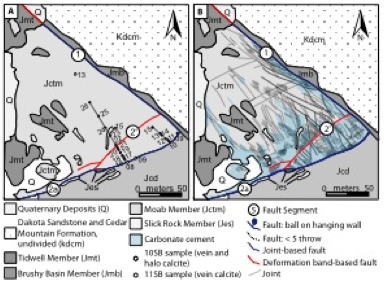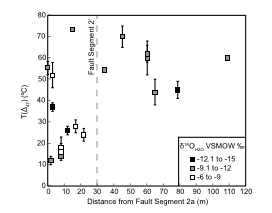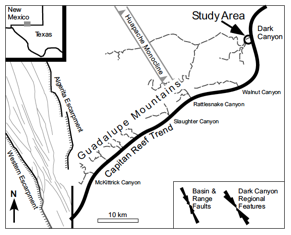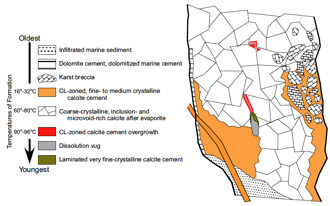57th Annual Report on Research 2012 Under Sponsorship of the ACS Petroleum Research Fund
Reports: DNI249704-DNI2: The Use of Carbonate 'Clumped Isotope' Thermometry to Quantify Temperatures of Burial and Diagenesis from 0-200C
Katharine W. Huntington, PhD, University of Washington
Quantifying the temperature conditions under which diagenesis and fluid flow modulate hydrocarbon maturation,
porosity, and permeability is important for predicting hydrocarbon formation
and preservation in tectonically active basins. Clumped isotope
thermometry determines the growth temperature of carbonate minerals based on
the abundance of 13C-18O bonds in the carbonate crystal
lattice, potentially enabling the thermal conditions of fracturing, fluid flow,
and growth of diagenetic minerals in hydrocarbon
reservoirs to be determined independent of the composition of coexisting
fluids, pressure, or time. A single 13C-18O clumping
measurement provides independent estimates of the growth temperature,
![]()
![]()
![]()
Clumped isotopes reveal the influence of deformation style on fluid flow and cementation along the Moab Fault, Paradox Basin, Utah
Brittle fault systems can serve as either conduits or barriers to fluid flow, impacting mass and heat transfer in the crust and influencing the potential storage and migration of hydrocarbons and geothermal fluids. For fault systems in porous sandstones, different classes of structures control both hydrological and mechanical behavior during fault evolution: while cataclastic deformation bands form zones of localized deformation and crushed grains that reduce permeability within and across fault zones, joints can act as significant conduits for fluid. We investigated the relationship between structures and fluid flow in porous sandstones by studying calcite cements along the Moab Fault, a large normal fault system in the Paradox Basin, Utah.
We used clumped isotope thermometry of fault cements to independently determine both the temperature and δ18O of the water from which the cements grew, placing new constraints on the source and path of diagenetic fluids in the basin. Based on fluid inclusion micro-thermometry and stable isotopic analysis of calcite cements from the Moab Fault, previous workers have hypothesized that joints served as conduits for the ascension of warm (84-125 °C) basinal fluids and deeply circulating meteoric waters. At the minor joint-dominated fault segment from which these data were collected, clumped isotope temperatures range from 57±10 to 101±2°C (2 SE), consistent with this hypothesis. However, at the nearby intersection of two major fault segments – in a zone characterized by both deformation bands and abundant joints – we found a broad range of temperatures (12±4 to 78±4°C) that vary spatially with distance from the fault and correlate with variations in secondary deformation structures (joints and deformation bands). These data provide the first evidence for cement growth from Earth surface-temperature fluids along the Moab Fault and suggest that the Fault served as a conduit for both ascending and descending fluids.
The spatial distribution of low-temperature cements argues for rapid penetration of surface waters flowing down intensely-jointed fault intersections and suggests that deformation-band faults served as low-permeability baffles, preventing lateral migration of cold fluids. This interpretation is consistent with the cathodoluminescence patterns and δ18O and δ13C values of the samples, and confirms the important role of structures in transmission and compartmentalization of fluids in porous rocks. Our study, submitted to the American Journal of Science (Bergman et al., submitted), illustrates how clumped isotope thermometry can aid in understanding interactions of mechanical, chemical, and transport processes associated with fractures and faults.
Syndepositional deformation features in high-relief carbonate platforms: long-lived conduits for diagenetic fluids
Syndepositional faults and fractures are known to affect early fluid flow in carbonate platforms. Less clear is whether they are active fluid conduits throughout a strata's entire history. Syndeformational fractures in Permian carbonate exposed in Dark Canyon, Guadalupe Mountains, NM, address this question. We studied these carbonates using transmitted and cathodoluminescent petrography, stable-isotope and fluid-inclusion analyses, and clumped isotope thermometry, and showed that there were multiple episodes of fracturing, dissolution, cementation, and replacement in the fractures. Although this study was not part of the original PRF proposal, the Colorado Plateau pilot study fostered new collaborations with David Budd and co-workers and extension of our work to the Guadalupe Mountains (Budd et al., in press).
Impact of the research
The research described in this report
- Formed the Masters project of Sarah Bergman, who successfully defended her thesis in June, 2012, and is currently employed as a chemistry and geoscience teacher in Denver, Colorado.
- Provided field, laboratory, and research experience for UW undergraduate David Birlenbach, who is now a first-year grad student at U of Illinois.
- Helped justify the PI's successful grant applications for both a cold cathodoluminescence microscopy setup (ConocoPhillips; University of Washingon) and a clumped isotope mass spectrometer (National Science Foundation) for her lab.
- Fostered new collaborations of the PI with Juliet Crider (UW), David Budd (CU Boulder), Ned Frost (Bureau of Economic Geology, UT Austin), Patricia Allwardt (ConocoPhillips Subsurface Technology).
- Created opportunities for ongoing and future work with Peter Eichhubl (UT Austin) to directly compare fluid inclusion homogenization temperatures and clumped isotope results in the same sample and to improve the precision of clumped isotope thermometry by analyzing synthetic calcite grown at known temperatures between 50-200°C. We completed calcite precipitations at <100°C at UW and at 100, 150, 175, 200, 225°C with Jim Gardner (UT Austin), and the samples will be analyzed with the new mass spectrometer.
In summary, results from the Colorado Plateau (Huntington et al., 2011), Paradox Basin (Bergman et al., submitted) and Guadalupe Mountains (Budd et al., in press) demonstrate the utility of clumped isotopes for determining fluid migration temperatures and isotopic compositions in the shallow crust for structural diagenesis studies. This work will serve as a model for combining clumped isotope thermometry with isotopes, other temperature proxies, petrography, and structural geology of basins to constrain the thermal and chemical history of fluids in tectonically active reservoirs.

















